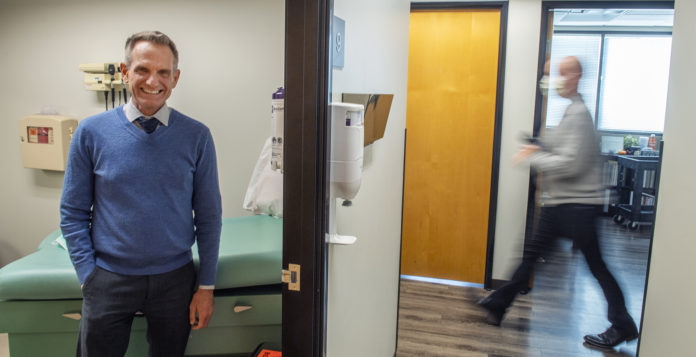
Tucked into a tubular office space inside an auxiliary building, just a quick cross-campus walk away from St. Mary Medical Center, the hospital’s CARE Center is easy to miss. But behind the unassuming door sits a powerhouse that has been serving Long Beach’s LGBTQ community for more than three decades.
Founded during the AIDS epidemic of the mid-80s and early 90s, the CARE Center at St. Mary Medical Center was once squarely focused on helping HIV-positive patients survive the deadly disease. Today, helping patients in the LGBTQ community take care of their mental health, alleviating housing insecurity and prevention are at the core of its mission—and so is helping them escape the grasp of a new pandemic.
During the early days of the AIDS epidemic, the situation was dire. “There were few services, there was a lot of fear, there was a lot of stigma,” said Paul Lovely, the center’s executive director. Scores of gay men would end up in the hospital’s emergency room, ravaged by the disease for which there was no cure and, at the time, little relief. “They were very sick and they had nowhere to go,” Lovely said.
Seeing the devastation, infectious disease specialist Dr. David Tillmann, social worker Jennifer Andrews and hospital President Sister Lucille Desmond decided it was time to create a center at St. Mary Medical Center that focused on helping the city’s underserved LGBTQ community in this time of crisis.
“They were just dealing with survival,” Lovely said.
Slowly, the center began expanding its services from merely connecting HIV-positive patients with medical care providers and social services in the region to providing those services on-site, with a team of dedicated social workers, physicians, therapists and even dentists.
Today, the center provides wraparound services that can meet almost any needs patients may have, from substance abuse treatment to dental fillings. “All with the goal of keeping patients with HIV in care,” Lovely said.
Joey Hubert, 68, has been using the center’s services for almost two decades. When he was diagnosed with cancer in 2019, the center provided him with an in-home caretaker. Recently he had his teeth fixed there, too. During the pandemic, Hubert, who is retired and receives social security, relied on bi-weekly food donations from the center.
“I’ve been poor basically my whole life, but I take care of myself,” Hubert said. The center has played a significant role in taking care of his basic needs. “The best thing of it all is that it’s all in one place.”
Once focused on mere survival, today the center deals with a plethora of medical and social challenges. Trauma, substance abuse and housing insecurity are among the most common needs to address, Lovely said. “There’s still a lot of damage.”
The current pandemic has added a dimension of need among the center’s patients, especially with regards to their mental health. Mental health visits doubled as the pandemic triggered memories of the worst days of the AIDS crisis, mixed with fear and isolation brought on by this new public health emergency.
Licensed clinical social worker John Blasco said he’s been working nonstop since the pandemic started, talking patients through their depression, anxiety and increased substance abuse.
“Those kinds of anxieties were activated a lot more strongly with long term HIV survivors,” Blasco said. “They’re traumatized by the previous pandemic.”
Despite the challenges brought on by the current pandemic, work at the center has its bright spots, according to Lovely, the executive director. “There are all these challenges, but you see people come out the other side and you see people’s lives that are transformed,” he said. “They thought they were just coming here to get a prescription filled for their HIV medicine and then we were able to give them so much more.”
One of the more recent highlights has been the introduction of pre-exposure prophylaxis or PrEP, which prevents HIV-infections among at-risk patients, many of them young gay men. Roughly 400 of the center’s 2,000 patients are HIV-negative, and receiving their PrEP medication through the center is helping them avoid infection.
The significant progress made in HIV treatment is another. What was once a toxic cocktail of “handfuls of pills,” as Lovely describes it, has now been reduced to once daily pills or even once-a-month shots that suppress almost all symptoms of the disease. “Now, people who get diagnosed early, they’ll never be sick a day in their life,” Lovely said.
The center’s patient population has a 90% viral suppression rate, which is significantly higher than the state average of 66.6% and meets the goal set by the national “Ending the HIV Epidemic: A Plan for America” initiative.
Sustained HIV viral suppression virtually eliminates HIV transmission to sexual partners, improves the health of people living with HIV and is widely used as a marker for the health care quality patients receive.
The center’s patients are getting older, too. Most of them are now in their 40s and 50s, according to Lovely, which he says is a good sign. “It means that they’re living.”








